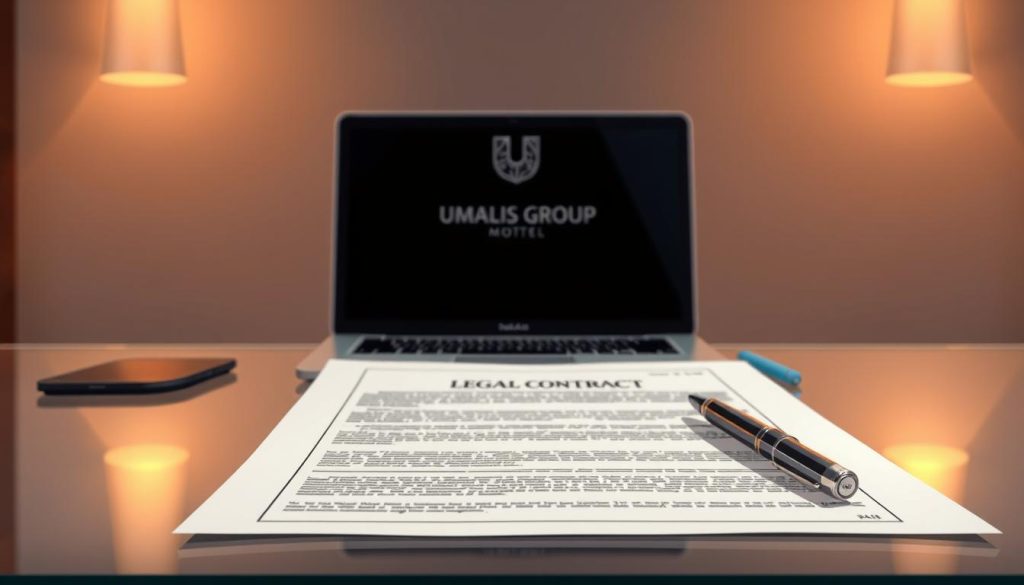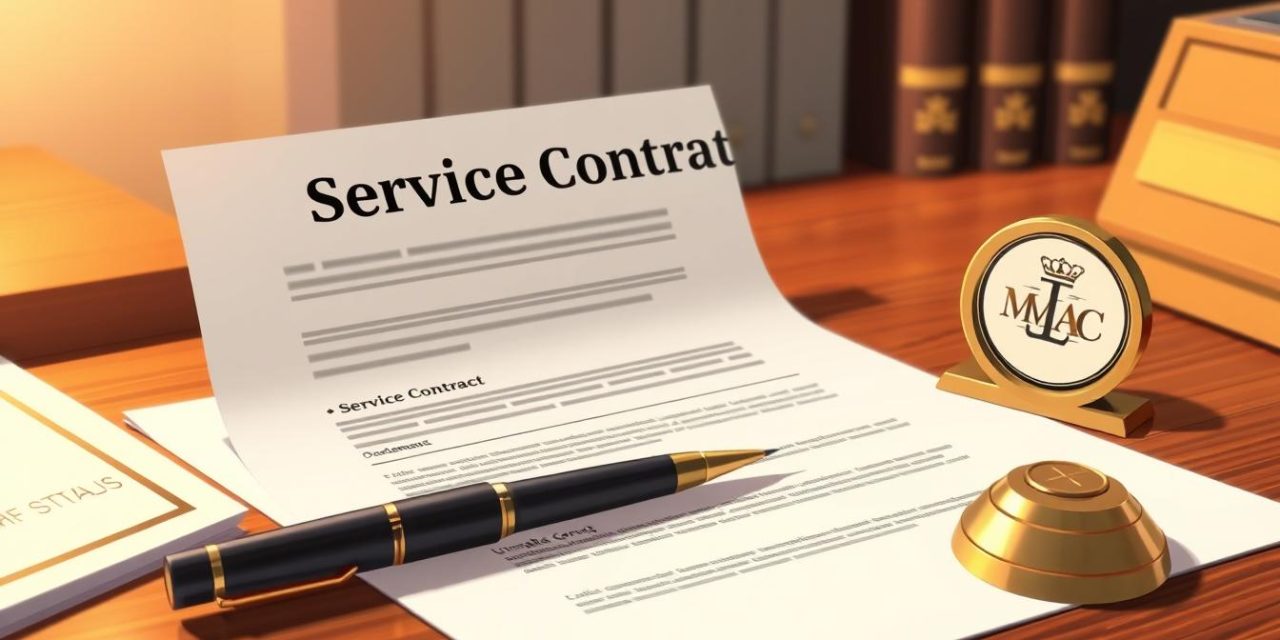Surprising fact: nearly half of freelance disputes start from unclear expectations, not bad work.
As an independent professional in France, converting informal talks into a clear service contract protects your work and your clients. A well-written contract spells out scope, payment, duration, responsibilities, termination, and dispute resolution so both parties know what to expect.
We focus on practical clauses you should never skip and on how a strong agreement reduces risks to your business and preserves client relationships. You’ll get clear, actionable steps that match your daily reality: juggling clients, keeping quality, and staying paid.
Automation saves time: tools can turn one template into many agreements, link to spreadsheets, and speed e-signing to close deals faster. Learn more about a solid model for France in this short guide: model contract overview.
Table of Contents
Key Takeaways
- Turn informal deals into a clear service contract to prevent disagreements.
- Include parties, scope, payment, duration, and dispute clauses.
- Automation reduces errors and speeds signature and delivery.
- A precise agreement protects your business and client relationships.
- Focus on simple, enforceable terms to lower risks and build trust.
Why Service Contracts Matter for Independent Pros in France
When stakes rise—especially in construction or office projects—a precise written agreement becomes your primary risk-management document.
In France, written service contracts convert verbal deals into enforceable terms under civil law. This reduces ambiguity for each party and makes expectations clear.
For high-risk work—large builds, IT rollouts, or multi‑year rentals—the paperwork records deliverables, costs, and deadlines. That clarity keeps your project on time and limits financial risk.
Even routine maintenance benefits. A short clause on access windows, response time, and incident handling avoids daily friction with a client.
Clear wording also helps with compliance and with corporate procurement teams. It explains how success will be measured, when payments are due, and what happens if requirements change.
| Scenario | Main risk | Why a written agreement helps |
|---|---|---|
| Small purchase | Minor delay | Quick confirmation of scope and payment |
| Construction project | Large financial and liability risk | Allocates responsibility, schedules, and penalties |
| Maintenance contract | Operational downtime | Defines SLAs, access, and incident flow |
| IT rollout | Integration failure | Specifies deliverables, tests, and acceptance |
Service Contract Basics and the Legal Foundation
The French Civil Code frames paid work as a louage d’ouvrage. Article 1710 creates a legal basis that sets mutual rights and obligations between the party buying the work and the person delivering it.
Define the parties precisely. Identify the client and the service provider by full legal name, legal status, share capital, registered office, legal representative, and RCS number. Include signature lines and initials on each page to strengthen enforceability.
Clarify the type of work and the measurable outcome. State whether the agreement covers consulting, training, design, maintenance, or rentals. Explain how success is measured and when payment follows.
How this differs from employment
Unlike an employment contract, this agreement preserves independence: the provider controls how the work is done and is paid for deliverables, not hours under supervision.
- Why it matters: this distinction affects taxes, social charges, and compliance.
- Practical step: avoid clauses implying subordination, fixed schedules, or exclusive control.

When a Written Agreement Is Essential versus Implied Arrangements
When timelines stretch and costs rise, a written agreement becomes a practical shield for both parties.
Use implied arrangements only for trivial, low-risk exchanges—like routine purchases where time and cost are minimal.
For high-stakes work such as construction or large IT rollouts, a written contract is essential. Complexity multiplies: design errors, supply delays, and subcontractor failures create exposure for the client and your business.
- Document milestones and payments: capture schedules, acceptance criteria, and payment checkpoints to avoid disputes over time or quality.
- Define operational rules: for office rentals and managed IT, spell out access, service windows, service credits, and remedies so daily operations run smoothly.
- Clarify change control: written terms make adaptations explicit and reduce errors that lead to rework or extra cost.
« A clear contract guides resolution when a customer escalates a concern and helps preserve the working relationship. »
Even for moderate engagements, a short, written model agreement reduces risk and prevents costly misunderstandings. For a practical model agreement, use clear milestones and dispute procedures so both client and provider stay aligned.
Common Types of Service Contracts
Choosing the right agreement type helps protect performance, set clear expectations, and simplify day-to-day management.
General agreement: Suited for ongoing work and regular upkeep. It defines scope, cadence, payment rhythm, and who is responsible for recurring tasks.
Consulting arrangement: Focuses on deliverables—audits, reports, and training. Include confidentiality and IP clauses to protect insights. For a practical model, see our consulting example.
Managed offering (IT/telecom): Relies on SLAs with clear metrics. Define uptime targets, response times, penalties, and monitoring duties so performance is measurable.
Maintenance and support: Prioritizes quality and uptime. Add scheduled checks, incident handling, and escalation paths to match client operations.
Retainer model: A fixed monthly fee buys prioritized availability and a defined bucket of work. It trades predictability for access.
Independent contractor agreement: Confirms freelance status, clarifies deliverables, and preserves independence from employment rules.
- Tip: Standardize templates—scope blocks, SLA matrices, and acceptance criteria—to save drafting time.
- Example: MSP monitoring with 99% uptime and 30-second alert response.
| Type | Primary focus | Key clause | When to use |
|---|---|---|---|
| General agreement | Ongoing delivery and maintenance | Scope, cadence, payment schedule | Monthly retainers or recurring work |
| Consulting | Deliverables and expertise | Confidentiality & IP | Short projects, audits, strategy |
| Managed (IT/telecom) | Operational performance | SLA with uptime and remedies | 24/7 support, network ops |
| Independent contractor | Freelance assignments | Independence and deliverables | Project-based freelance work |
Essential Clauses: Terms, Conditions, and Protections
A compact set of clauses turns vague promises into clear, enforceable obligations that protect both parties. This section lists the must‑have elements to include in any service contract for work in France.
Contracting parties and identification
Name each party with full company name, legal status, share capital, registered office, legal representative, date of signature, and RCS number. Require initials on each page and signatures to strengthen enforceability.
Scope, deliverables, deadlines
Describe the work, acceptance criteria, and completion deadlines. Make outcomes measurable so progress and remedies are objective. Distinguish obligation of means from obligation of result for construction or outcome‑driven work.
Payment, SLAs, and protections
Set amounts, schedule, milestones, and penalties for late payment or delay. Add performance and availability targets with remedies or service credits. Include a clear confidentiality clause that defines protected information and duration.
IP, warranties, force majeure, and dispute resolution
Specify IP transfer or license timing (for example on acceptance or full payment), warranties, rework windows, and risk allocation for force majeure events. State governing law, competent court, and a tiered path to resolve disputes (negotiation, mediation, arbitration).
Defining Roles and Responsibilities between Provider and Client
A precise split of duties ensures both parties know who does what and when to act. Clear role definitions keep the work on track and reduce costly delays.

Provider duties
As a provider, deliver the agreed deliverables to the quality standards defined in the contract. Communicate progress and raise issues early so problems are solved, not hidden.
Meet applicable compliance rules and keep accurate records. Issue invoices promptly and track payment milestones so cash flow matches the terms.
Client duties
The client must supply correct information, approve work on time, and make payments per the agreed schedule. Timely feedback prevents bottlenecks.
Give access to systems or sites and confirm who can authorize scope changes. Cooperation keeps timelines realistic and protects both parties from misunderstanding.
- Set response times for questions and change requests.
- Document approvals and decisions in writing.
- Agree how work is accepted and how minor defects are fixed.
Strong, explicit responsibilities in a contract align expectations, reduce friction, and keep both parties accountable to the same obligations.
Service Contracts in Practice: Management, Automation, and Disputes
Good drafting and fast workflows help you move from offer to execution without needless delay. Keep records that show offer, acceptance, consideration, capacity, and intention so a contract holds up under law.
Drafting for enforceability
Make core elements explicit. Record the offer, written acceptance, and the consideraton that shows mutual exchange. Confirm the parties’ capacity and clear intent so terms are enforceable.
Termination mechanics
Fixed-term agreements usually run until the end date unless both parties agree or a serious fault occurs. Open-ended arrangements allow termination with the notice defined in the agreement.
- Use tiered notices and cure periods to reduce disputes and preserve project continuity.
- Keep a register of renewal dates and notice windows to avoid unexpected rollovers.
Automating to reduce errors and speed completion
Standardize a template and link it to data sources to cut drafting errors. Integrate review and e-sign flows to accelerate completion and capture version history in real time.
« Document, notify, and escalate: follow the agreed procedure to resolve disputes efficiently. »
Conclusion
Wrap up your process with simple rules that keep projects on time, paid, and risk‑aware.
Keep essentials clear, including precise terms, company details, scope, payment milestones, and remedies. These elements protect your rights and help maintain quality across sectors from IT to construction.
Standardize templates so you can scale work with consistency. Use automation to shorten the cycle from draft to signature and reduce errors.
Refine clauses as you learn. Each iteration strengthens your agreements and makes dispute resolution faster and fairer for you and your customer.
For a practical starting model, review our model contract and operationalize this guidance today.
FAQ
What is a service contract and which parties are involved?
A service contract is a written or verbal agreement where a provider commits to perform specific tasks for a client in exchange for payment. Parties include the provider (individual or company) and the client (business or private person). The agreement should identify legal status, registration details (RCS), and contact information to avoid ambiguity and ensure enforceability.
How does French law treat agreements for work versus employment?
Under French law the “louage d’ouvrage” concept applies to contracts for work: the provider delivers a result, not an employer-style subordinate relationship. Employment contracts involve subordination, salary and social protections. Clear contract terms and operational separation help prevent reclassification risks.
When is a written agreement essential?
Put agreements in writing for high-risk or complex projects—construction, IT development, large maintenance, or multi-phase consulting. Written terms protect both parties on scope, deadlines, payment and liability. For low-risk, short tasks, a written note is still recommended to clarify expectations.
What key clauses must be in a reliable agreement?
Include parties’ identity, detailed scope of work, deliverables and deadlines, payment schedule and penalties, performance levels (SLA), confidentiality, IP ownership, warranties and remedies, force majeure, governing law and dispute resolution. These elements reduce ambiguity and preserve rights if issues arise.
How should payment terms be structured to reduce disputes?
Define amounts, invoicing schedule, milestones, accepted payment methods and late-payment penalties. Tie partial payments to verifiable deliverables or acceptance tests. Clear terms speed cash flow and limit disagreements about completion or quality.
What protections exist for intellectual property in these agreements?
Specify whether IP is assigned, licensed or remains with the creator. Detail scope, duration and any moral rights that cannot be transferred under French law. For custom development or creative work, include transfer clauses and usage rights to avoid downstream conflicts.
How do service level agreements (SLAs) work in managed and IT contracts?
SLAs set measurable metrics—uptime, response time, resolution time—and remedies for breaches such as credits or penalties. Include monitoring methods, reporting cadence and exclusion cases. Well-defined SLAs align expectations on performance and maintenance.
What are typical client responsibilities to ensure project success?
Clients must provide timely information, approvals, access to systems or sites, and on-time payment. Explicit cooperation obligations and designated contact persons prevent delays and support compliance with agreed timelines.
How do termination clauses differ for fixed-term and open-ended agreements?
Fixed-term contracts end on a specified date or upon completion; early termination requires predefined grounds and penalties. Open-ended agreements should include notice periods, cause definitions and steps for remediation. Clarify post-termination obligations such as final deliverables and data return.
What steps reduce legal risk when drafting or automating agreements?
Use clear, plain-language clauses; ensure offer, acceptance and consideration are documented; verify parties’ capacity and authority; and include governing law. Automation templates with required fields, version control and e-signature reduce errors and accelerate closing while preserving enforceability.
How are disputes commonly resolved and which forum should we choose?
Resolve disputes by negotiation, mediation, or arbitration before litigation. Specify governing law (commonly French law for contracts performed in France) and the competent court or arbitration seat. Alternative dispute resolution saves time and preserves business relationships.
What is force majeure and how should it be handled in a contract?
Force majeure covers unforeseeable events beyond parties’ control (natural disasters, strikes, major regulation changes). Define triggering events, notice obligations, suspension and termination rights. Clear clauses allocate risk and limit liability during exceptional circumstances.
How do warranties and remedies protect the client and the provider?
Warranties set expected quality or performance standards and duration. Remedies can include repair, replacement, price reduction or termination. Caps on liability and exclusion clauses balance risk—ensure they are reasonable and compliant with mandatory law to remain enforceable.
What should freelancers include in an independent contractor agreement?
Freelancers should state offered tasks, deliverables, timelines, fees, invoicing procedures, IP arrangements, confidentiality, and termination terms. Include clauses on non-exclusivity, liability limits, and professional indemnity to protect both sides and clarify the business relationship.
When is a retainer appropriate and how is it structured?
Use a retainer for ongoing availability—legal advice, consulting or maintenance. Structure with a defined monthly fee, scope of included hours or services, overage rates, and renewal terms. Retainers provide steady income and predictable access for clients.
How can companies ensure compliance with corporate information requirements?
Verify the counterparty’s legal status, capital, RCS registration and authorized signatories before signing. Requiring up-to-date company documents and confirming authority to bind an entity reduces fraud and supports valid contract formation.
What role does confidentiality play and how strict should NDAs be?
Confidentiality protects trade secrets, client data and proprietary methods. Draft NDAs that define confidential information, permitted uses, duration, and return or destruction obligations. Balance protection with practical exceptions for required disclosures to authorities or advisors.




![Discover Portage Salarial in [Sector] with Trusted Support](https://blog.simulateur-portage-salarial.fr/wp-content/portage-salarial-dans-le-secteur-de-specific-sector-440x264.jpg)
